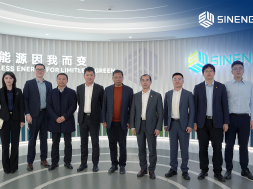
India’s renewables revolution needs what other countries are fast adopting: water battery
Pumped hydro energy storage can pave the way for India’s climate leadership by enabling another green revolution, this time in the power sector.
Progress in energy storage will soon mean energy security for India, as the country races ahead with large renewable power commitments. Already fifth in the world in renewables, India now says it will exceed its 2022 target of 175 gigawatts of installed renewable capacity. Speaking at the United Nations Climate Action Summit in September, Prime Minister Narendra Modi committed his nation to more than doubling that target, to 450 gigawatts.
Yet, regardless of total capacity, we know discontinuous power is inadequate power. Wind and solar technology can generate electricity only when the wind blows or the sun shines, and green power that floods the grid and then recedes puts immense pressure on transmission systems and end users alike. Balancing this fluctuating supply is the lynchpin of a clean energy future, and the key to achieving that balance is reliable and efficient energy storage.
India hasn’t moved as swiftly on storage as it has on generation, however, leaving its lofty green commitments incomplete. The government has conducted only sporadic lithium-ion storage tenders and pilot projects, and there have been only small-scale storage experiments in the private sector.
But this delay in adopting a formal energy storage target like the one for renewable generation may be a blessing in disguise. As competing storage technologies have matured, India is positioned to pick and choose to build a diversified storage mix that best suits its renewable energy strategy. Now, a technology in widespread use elsewhere, but which has received relatively little attention in India, is getting a second look for its efficiency and feasibility: pumped hydro energy storage—essentially a water battery.

Pumped hydro energy storage, or PHES, works on the simple principle of storing potential energy in water that’s pumped into an elevated reservoir. At times of high electricity demand, this water can be released to a lower reservoir, passing through turbines that generate power. At times of surplus power, electricity can be used to pump water back into the upper reservoir.
PHES is particularly suited for load management. It takes only seconds to bring PHES systems online—much less time than coal- or gas-fired peaker plants. PHES is especially competitive where a suitable reservoir already exists, making it an ideal technology for the present moment when lithium-ion battery systems are still maturing. So-called “off-river” or closed-loop PHES systems minimize impacts on water resources by repeatedly recycling the same water for pumping and generation.
The suitability of PHES for India recently emerged in a stakeholder consultation convened by The Asia Foundation in partnership with the Indian research group Integrated Research and Action for Development (IRADe). Until recently, the greatest challenge to pumped hydro systems was the years it took to identify suitable national universities under DFAT’s Sustainable Development Investment Program (SDIP). The map shows hundreds of locations in India, all reviewable from the comfort of a desktop, radically reducing the time required for site identification.

Though it hasn’t yet taken off in India, pumped hydro accounted for over 94 percent of global energy storage capacity in 2018, ahead of lithium-ion and other forms of storage, according to research by the International Hydropower Association. China, the largest installer of renewable energy in the world, is building up to two-thirds of the 78 gigawatts of pumped storage currently being installed globally. In October, Dubai awarded a contract for a 250-megawatt PHES project in the Hajar mountains, the first in the Arabian Gulf, as part of its clean energy plan for 2050. And in August, the Green Climate Fund said it will participate in a solar power and pumped storage project in Chile as an early, anchor investor, helping to reduce project risk and attract investments from other investors and lenders.
According to the Central Electricity Authority, India has a potential 96 gigawatts of PHES capacity, just 2.6 gigawatts of which is currently operational. PHES, in principle, can operate without fossil fuels, and pumped hydro systems have a longer service life than coal and gas plants, making them an ideal partner technology for India’s push for wind and solar.

Finally, with its enormous economy and burgeoning power requirements, adequate storage is an energy-security imperative for India. If India can support its ambitious renewables targets with suitable storage solutions, it can drastically reduce coal and oil imports, ushering in greater energy self-reliance. Without PHES, India will miss out on a mature and reliable technology to support its commitment to renewables. Clearly, the time has come to act swiftly. If pursued in earnest, PHES can pave the way for India’s climate leadership by enabling another green revolution, this time in the power sector.















